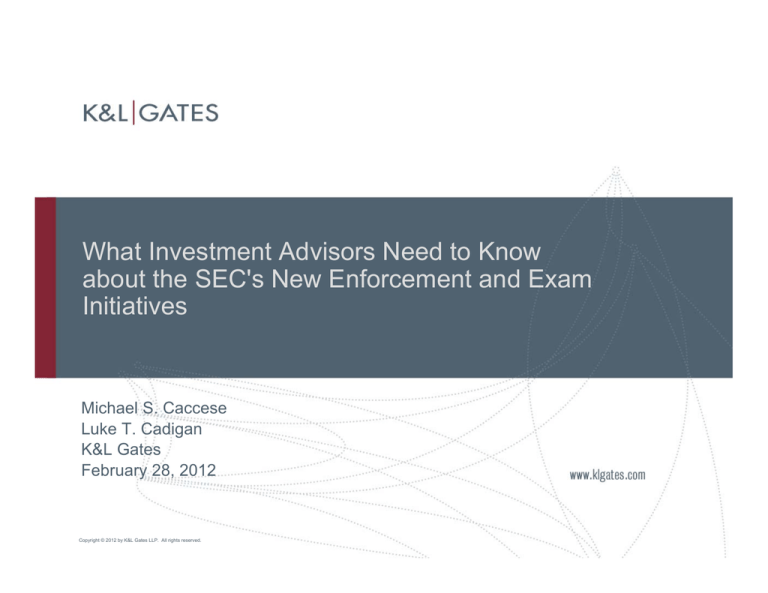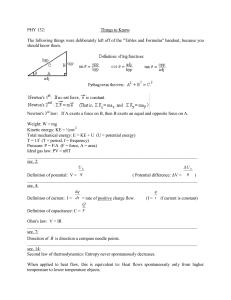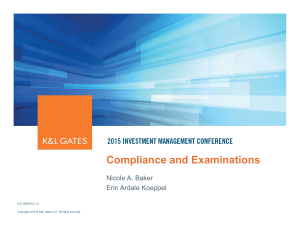
What Investment Advisors Need to Know
about the SEC's New Enforcement and Exam
Initiatives
Michael S. Caccese
Luke T. Cadigan
K&L Gates
February 28, 2012
Copyright © 2012 by K&L Gates LLP. All rights reserved.
Agenda – Enforcement Topics
Understanding the dynamics at work within the
SEC
Interaction of Enforcement & OCIE
Overhaul of Enforcement Division
Whistleblower program
Asset Management and other specialized units
Legal challenges facing Enforcement program
Tips for dealing with the Enforcement staff
1
Agenda – Examination Topics
Effect of the Dodd-Frank Act on the Examination
program
Structural changes at OCIE and their effect on
the Examination program
Examination tools and how they are being used
Areas of focus for OCIE
Tips for dealing with the Examination staff
2
Factors Affecting the SEC in 2012 and Beyond
Missing Madoff
New structure and new tools
Ambitious agenda and aggressive approach
Insufficient staff and other resources
Risk-based approaches and whistleblowers
Legal and practical challenges
Political pressure and public opinion
The human dynamic
3
SEC Divisions
Enforcement
• Investigates and prosecutes securities violations
Trading and Markets
• Regulates broker-dealers and stock markets
Investment Management
• Regulates investment advisers and investment companies
Corporate Finance
• Oversees public company filings
Risk, Strategy, and Financial Innovation
• Conducts risk, economic, and other data analyses
4
Office of Compliance, Investigations, and
Examinations (OCIE)
Administers SEC’s nationwide examination and
inspection program
Conducts exams of registered entities, including
•
•
•
•
•
•
•
•
Investment advisers
Investment companies
Broker-dealers
Transfer agents
National securities exchanges and clearing agencies
Nationally recognized statistical rating organizations
Self-Regulated Organizations
Public Company Accounting Oversight Board
5
Enforcement and Exam Staffing in the
Regional Offices
Each SEC regional office is comprised of
Enforcement staff and Examination staff
Historically, functions kept relatively separate
More recently, there has been increased
coordination between Enforcement and OCIE
Each Regional Director oversees both functions
within region
Considerable interaction (substantive or other)
between staffs daily
6
Restructuring the Division of Enforcement
Creation of five specialized units
Elimination of Branch Chiefs
Delegation of authority to initiate formal
investigations
Cooperation program
• 37 cooperation agreements, 1 DPA, 3 NPAs
Whistleblower program
Enhanced Tips, Complaints, Referrals System
• Office of Market Intelligence
7
Division of Enforcement FY 2011 Stats
Record 735 enforcement actions
Near record $2.8 billion in penalties and
disgorgement
Over past three years, actions against IA/ICs
rose more than 92%
Last year, actions against B/Ds rose 60%
Insider trading cases rose nearly 8%.
Drop in accounting fraud cases to 10-year low
8
SEC Whistleblower Program
SEC enforcement action with sanctions over $1
million
SEC must pay 10-30% of recovery
• To any eligible whistleblower
• Who has voluntarily provided the SEC with
• Original information about a possible violation of
the federal securities laws
9
SEC Whistleblower Program in Practice
334 whistleblower tips in first seven weeks
Top categories:
•
•
•
•
•
Corporate disclosures and financial statements (15.3%)
Offering fraud (15.6%)
Market manipulation (16.2%)
Insider trading (7.5%)
Other (23.7%)
10% of tips came from foreign countries
Too small a sample to draw conclusions
SEC claims to be receiving 7 tips a day
10
SEC Treatment of Whistleblower Claims
Numerous pros and cons for SEC staff
SEC makes initial assessment as to whether claim has
substance
Given past criticism, SEC takes all whistleblower claims
seriously
Claims generally given disproportionate attention and
resources
Claimant, often represented by counsel, has monetary
interest in success of investigation
Claims present difficult matters to close
SEC looking for cases to bring attention to the program
11
SEC’s Interactions with the Company
So long as it serves the SEC’s purposes, it will keep secret the
involvement of the whistleblower and the nature of the
allegations
• SEC need not tell company counsel that it is talking with
the whistleblower, even if a current employee
Gives the government an opportunity to assess the extent of
the company’s cooperation
Can be in the government’s best interests to keep the
company guessing
The company will eventually get opportunity to respond to
allegations but what record will exist by then?
From the beginning, assume there is a whistleblower
12
Encouraging Reports to Company First
Underscores need to review company’s current internal
reporting process to ensure that employees are motivated
to come to the company first
• Effective internal reporting process
• Explanation of company’s need to know about
concerns
• Expectation that employees will report
• Active encouragement of reports
• Instructions on how to report
• Explanation of how report will be handled
• Guarantee that there will be no retaliation
13
Enforcement Specialized Units
Asset Management
Market Abuse
Foreign Corrupt Practices Act
Structured and New Products
Municipal Securities and Public Pensions
14
How do the Specialized Units Work in
Practice?
Staff attorney(s) in unit work the matter, sometimes
with non-unit help
Supervised by Assistant Director in Unit/Region
Unit Leadership and Regional Leadership have
relatively equal say in recommendation
15
Asset Management Unit Current Areas of Focus
Valuation issues (side pockets, liquidity
representations, marking the close, etc.)
Conflicts of interest (related party transactions,
transactions between co-managed funds, side letters)
Compliance controls and governance (must be
geared to risk of firm)
Sales practices (are products appropriate to
investors?)
Private equity firms (valuation, conflicts of interest,
fees, zombie funds, performance claims)
Small advisers (compliance programs, Ponzi
schemes)
16
Asset Management Unit Initiatives
Hedge fund aberrational performance initiative
• Use of analytics to identify returns too good to be true
Compliance program initiative
• Aimed at ensuring all IAs have compliance programs
in place
Problem adviser initiative
• Scrutiny of misrepresentations as to education,
experience, and performance
17
Asset Management Unit Initiatives
Mutual fund fee initiative
• Board oversight of fees and valuation determinations
Preferential redemption initiative
• Investors permitted to redeem on preferential terms
Bond fund initiative
• Disclosure and valuation issues in illiquid portfolios
Private equity initiative
• Valuation, conflicts, fees, performance claims
18
Market Abuse Unit
Uses new computer-based tools to sift through data
to find relationships, aberrational trading, market
manipulation
Focus on large-scale insider trading at hedge funds
Departure from traditional insider trading actions
involving one or few trades (i.e., Arthur Samberg/
Pequot Capital)
Significant collaboration with USAO
• Use of wiretaps and cooperation tools
Galleon, Expert Network cases, many other
examples
Will benefit from consolidated audit trail (CAT)
19
Foreign Corrupt Practices Act Unit
FCPA prohibits bribes made to foreign officials in
order to obtain or retain business
FCPA also requires U.S. issuers to keep accurate
records and maintain adequate accounting controls
SEC/DOJ has an expansive definition of “foreign
officials”
• Includes employees of state-owned entities
SEC jurisdiction extends only to U.S. issuers, but
• U.S. issuers include foreign companies trading
on U.S. exchanges
20
FCPA Unit in Practice
Eight of ten largest FCPA settlements occurred in
FY 2010
SEC/DOJ has historically relied on self-reports
Now using proactive, risk-based approaches:
• Industry-wide sweeps
• Examination of corrupt actors and programs
• Scrutiny of companies successful in countries
perceived to be corrupt
SEC has high expectations of cooperation
Compliance program has dramatic impact on
investigation
21
Corruption Perceptions Index 2011: The perceived levels of public sector
corruption in 183 countries and territories around the world.
Adapted or reprinted from Corruption Perceptions Index 2011. Copyright 2011 Transparency International: The Global Coalition against Corruption. Used with
permission. For more information, visit http://www.transparency.org.
22
SEC’s Increased Willingness to Charge
Negligence
In SEC v. Steffelin, a contested matter, SEC
charged a GSC Capital executive with negligence for
his role in inadequate disclosures concerning
selection of CDO assets
While SEC would previously settle to negligence
claims, it rarely brought litigated actions on less than
fraud
SEC staff has publicly suggested that negligence
alone may provide a sufficient basis for future SEC
actions
23
The Citibank Decision and its Consequences
Standard SEC practice not to require admission in a
settlement – Defendant “neither admits nor denies”
Judge Rakoff rejected standard settlement
Currently on appeal to Second Circuit
Decision may have profound ramifications for SEC’s
enforcement program
24
Increased Use of SEC Administrative Process
Under Dodd-Frank, SEC now has broad authority to
impose penalties in APs for all securities violations
Trial to SEC administrative law judge with first
appeal to SEC de novo
No right to jury
No discovery (even of experts)
No dispositive motions (with minor exceptions)
All relevant evidence (including hearsay) is admitted
Trial within 4-5 months; decision within 10 months
25
Dealing Effectively with Enforcement Staff
Understanding of the process and the dynamics
at play
Credibility
Cooperation (where reasonable)
Competence
26
Trends in the OCIE Exam Program
Broad self-assessment and restructuring
National Examination Manual
Creation of centralized Risk Assessment and
Surveillance Unit
• Performs data analytics to identify firms and
practices that present the greatest risks to
investors
Days of cycle/routine exams are over
Focus on high-risk firms, some random sampling
New hedge fund and private equity registrants to get
particular attention
27
OCIE by the Numbers – IA/IC Exams
Responsible for exams of 10,600 investment
advisers and 940 investment companies
Only 460 staff members conducting IA/IC exams
Only 8% of registered advisers examined in FY 2011
38% of IAs have never been examined
Identification of high-risk firms for examination once
every three years
Hedge funds and private equity firms are among
those likely to be considered high risk
28
SEC’s Continuing Requests for Resources
SEC is seeking $1.566 billion for its FY2013 budget,
an increase of 18.55% over its 2012 appropriation
SEC states it has only 10 examiners for every trillion
dollars in AUM, down from 19 seven years ago
According to SEC, single firms often spend more
than entire agency on technology and legal resources
OCIE (968 staff) seeking to hire 222 new employees
Enforcement (1,351 staff) seeking to hire 191 new
staff
29
IA/IC Exam Referrals to Enforcement
Deficiency Letter – approximately 82% IA & 72% IC
Referral to Enforcement – approximately 10% IA
and 7% IC
Given risk-based selection and new approaches,
percentage of referrals likely to increase
Once referred, more difficult to close
Exam and Enforcement staff work side-by-side
Referral is significant step making matter more
difficult to close without first conducting serious
investigation
Risk of insulting OCIE staff when Enforcement
wants to encourage appropriate referrals
30
Effect of the Dodd-Frank Act on the Exam Program
Provided SEC with expanded authority and
responsibilities, including adding systemic risk as a
function of OCIE examinations
Tougher regulations placed upon participants affecting
how advisers solicit investments, conduct trading, and
report to investors and regulators
Advisers subject to “additional, special and other
examinations” as SEC deems appropriate
SEC can obtain sensitive confidential information from
advisers for surveillance or risk assessment purposes
OCIE must deliver exam results within 180 days of
completing the on-site portion of an exam (may be
extended for “sufficiently complex” exams)
31
National Examination Manual
Purpose and Goal: Nationalize the examination
program to ensure consistency across regional
offices
Significant features:
•
•
•
•
Automated National Examination Workbook will be designed to
drive consistency, effectiveness, efficiency, and accountability
in examination process nationwide
Examination processes and procedures will be the same
throughout the country
First draft already in use by examiners
Manual will be available to the public, like SEC Enforcement
Manual, after months of field testing
32
Specialist Examination Working Groups
OCIE has created six specialist working groups to
identify, understand and proactively examine new and
complex industry developments:
• Valuation
• Structured/new products
• Marketing and sales practices
• Equity market structure and trading practices
• Fixed income and municipal securities
• Microcap fraud
33
Senior Specialized Examiners and Training
The SEC has hired several Senior Specialized
Examiners
• Practiced industry professionals with specialized
experience in trading, portfolio management,
valuation, complex products, sales, compliance,
and forensic accounting
OCIE is providing examiners more regular and
relevant training — e.g., more than 300 became
certified fraud examiners last year
34
Enhanced Coordination with Enforcement
OCIE’s new Risk Assessment & Surveillance unit working
to assess risk with Enforcement’s Office of Market
Intelligence
OCIE reaching out to Enforcement more frequently and
informally when Exam staff sees potential issues
Enforcement now takes all OCIE referrals seriously
OCIE and Enforcement are working together on various
initiatives (e.g., Compliance Program Initiative)
35
New Examination Approaches
OCIE will conduct more background research before
entering the registrant’s premises
Examiners hope to arrive on site more knowledgeable
about registrant’s business model, asset risks and conflicts
Staff will want to engage and interact with the chief
executive officer, the board, and top principals of
registrants
Examiners may probe beyond compliance issues
Generally, examinations will be longer, more in-depth,
with more review of documents to verify compliance and
less reliance on interviews
36
Other Approaches to Be Aware of
Letter inspections for new hedge fund and private
equity registrants
• Will help OCIE determine on-site review targets
• Focus on compliance controls
Surprise examinations of investment advisers
based on TCRs and information on risk areas
referred by other SEC offices
• Unannounced arrival at advisers
• Intended to supplement, rather than replace, usual practice of
announcing examinations
Risk-targeted
examination sweeps
• Foreign Corrupt Practices Act, quantitative trading, due
diligence efforts by advisers to fund of funds, use of social
media
37
Continuing OCIE Focus on Risk
Quantitative
risks
• Form ADV disclosures
• The SEC/CFTC’s Form PF requires registered advisers to
hedge funds and other private funds to report certain
information to help OCIE estimate an adviser’s quantitative
risks
Qualitative
risks
• Qualitative risks may include, among other matters, a firm’s
reputation, its compliance and internal control environment,
and results of prior examination(s), including whether it
corrected previously identified deficiencies
OCIE
staff is focusing on increasing its technology and
database expertise to assist it in assessing risks
38
OCIE Focus on Risk Management
OCIE is focusing on risk management as it relates to
• corporate governance
• enterprise risk management (ERM)
• internal controls
Particular focus on these issues at larger firms
Process involves understanding each registrant’s business
model, products and asset classes, and evaluating the risks
and conflicts that are inherent in that business model
39
OCIE Focus on Risk Management
Exam staff is seeking an understanding of risk
management governance and compliance control
frameworks:
• How do the business units/product teams of a
firm ensure they are taking and managing risk
effectively?
• How are key risk management, control, and
compliance functions structured and resourced?
• How is board and senior management ensuring
effective oversight of enterprise risk
management?
40
OCIE Focus in Exam’s Initial Assessment Stage
Independence of legal and compliance departments and
officers
Adequacy and effectiveness of compliance and risk
functions, processes, and controls
Level of engagement of senior management in compliance
and risk processes, and whether they are setting a “solid tone
at the top”
Firm’s focus on and commitment to risk management
Adequacy and independence of internal audits
41
Top Substantive Areas of Focus for OCIE
New hedge fund and private equity registrants
Verification/confirmation of assets
• Compliance with the new custody rule, including the
verification of client assets by an independent public
accountant
Disclosure
• Conflicts of interest, valuation, risk, expenses
Performance claims
• Particular focus on quantitative models
Sales of new and complex products
42
Top Substantive Areas of Focus for OCIE
Resources
• Whether a firm has adequate compliance and internal audit
staff, including designation of a chief compliance officer and
an internal auditor
Control environment
• Whether internal controls are in place to prevent fraud and
other violations
Portfolio management
• Whether a firm’s strategy and investment follow the
representations made to investors
Mutual funds
• Reviewing the role of the board, advisory fees and valuation
43
Dealing Effectively with the Exam Staff
Understanding of the process and the dynamics
Credibility
Cooperation (where reasonable)
Competence
44
How to Avoid Turning a Routine Exam into an
Enforcement Referral
Be prepared
Be courteous and appropriately cooperative
Have compliance and other documents ready
Review past deficiency letters
Designate contact for the Exam staff
Prepare employees for staff interviews
Correct potential misimpressions promptly
Provide context for issues/dox where appropriate
Maintain log of documents requested and provided
Segregate privileged information
45
How to Turn a Routine Exam into an Enforcement
Referral
Be rude
Be evasive
Be uncooperative
Make statements fraught with inconsistencies
Fail to provide documents in a timely manner
Revise historical documents
Dismiss the Exam Staff’s concerns
Fail to show due respect to a regulator
The Lesson: Do not discount the human factor.
46
Questions?
Michael S. Cacesse
michael.cacesse@klgates.com
617.261.3133
Luke T. Cadigan
luke.cadigan@klgates.com
617.261.3118
47





